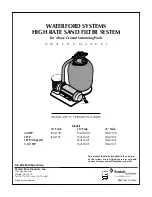
OPERATION
2
Cyanuric acid
is needed in outdoor pools to help to stabilize and maintain proper levels of chlorine.
90% of unstabilized chlorine is destroyed by the UV radiation from the sun within two hours. Cyanuric acid
stabilizes chlorine in water from UV degradation. When using the CFPT, the cyanuric acid level should be
maintained between 30-50 ppm.
DO NOT USE CYANURIC ACID IN INDOOR POOLS.
Total Dissolved Solids (TDS):
Adding salt to pool water will raise the TDS level. While this does not
adversely affect the pool water chemistry or clarity, the pool water professional testing for TDS must be
made aware salt has been added to the CFPT system. The individual performing the TDS test (see page
17) may then subtract the salinity level to arrive at a TDS level that would be compatible to a TDS reading
for a non-salt water pool.
Metals:
Some metals, i.e. copper and iron, can cause loss of chlorine. Also, metals can stain your pool.
Metals can also damage the CFPT. Have your local pool professional check for metals and recommend
methods of removal.
Nitrates and Phosphates:
can cause extremely high chlorine demands and will deplete chlorine from
your swimming pool. In some cases nitrates may even lower your chlorine levels to zero. Your local pool
professional can test for nitrates and phosphates. While a 0 ppm level of nitrates is the ideal, the pool
owner should make sure that nitrates
DO NOT
exceed 10 ppm.
IDEAL WATER CHEMISTRY LEVEL
How to test chlorine:
It is recommended that chlorine test samples be taken from two (2) locations in the
pool. Compare the samples. A higher level should be found at the pool return line. The higher level at the
pool return line indicates CFPT is producing chlorine.Take chlorine samples for testing at:
• The pool return line.
• 18 inches (457 mm) below the surface and well away from the pool return line.
What kind of salt?
It is important to use only sodium chloride (NaCl) that is 99% pure. This is common
food quality or water softener salt available in 40-80 lb/bag at your local store. It is also acceptable to use
water conditioning salt pellets; however, it will take longer for them to dissolve. Do not use rock salt, salt
with more than 1% yellow prussiate of soda, salt with more than 1% of anti-caking additives, or iodized salt.
FOR ALL NEWLY SURFACED PLASTER POOLS:
DO NOT
operate CFPT with newly surfaced pool plaster. Salt is a corrosive element and severe salt
damage can occur to your pool. Wait at least ONE (1) MONTH after construction to allow plaster to cure
before adding salt and operating CFPT. Follow the pool surface manufacturerʼs guidelines for your specific
pool. salt and operating CFPT.
FOR NEW VINYL LINER POOLS:
contact the manufacturer for recommended guidelines before adding.
Summary of Contents for 90154
Page 5: ...4 APPLICATIONS POUNDS and Kg OF SALT NEEDED FOR 3400 PPM ...
Page 13: ...PARTS LIST 12 ...
Page 14: ...TROUBLESHOOTING 13 ...


































